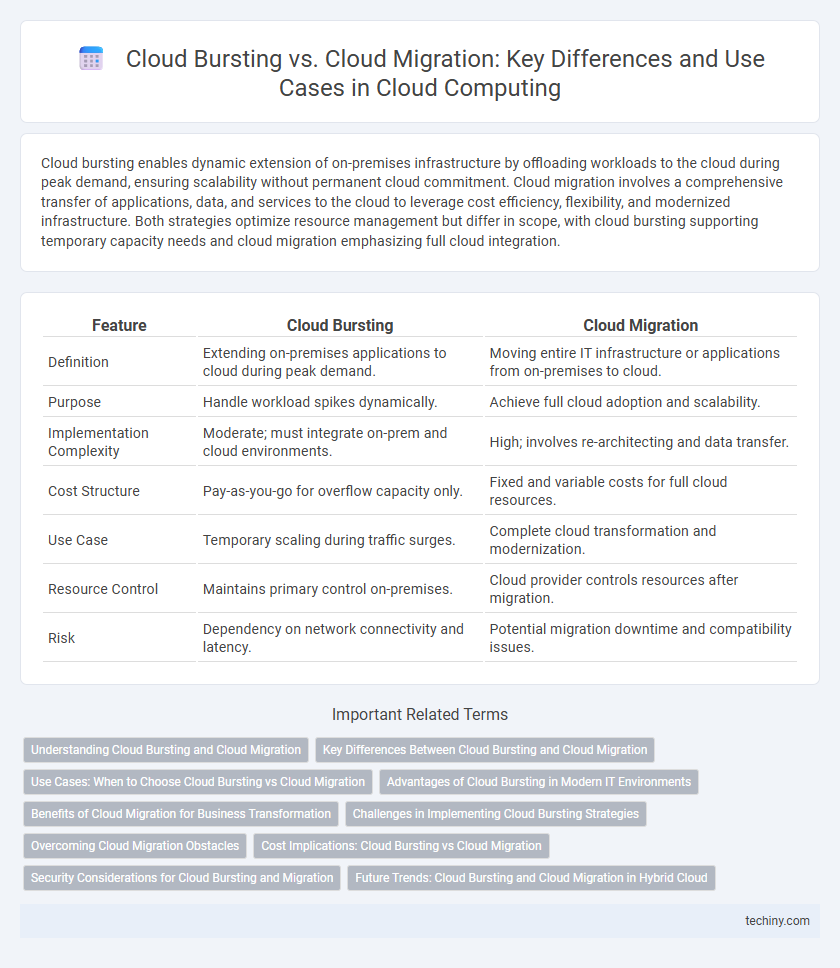Cloud bursting enables dynamic extension of on-premises infrastructure by offloading workloads to the cloud during peak demand, ensuring scalability without permanent cloud commitment. Cloud migration involves a comprehensive transfer of applications, data, and services to the cloud to leverage cost efficiency, flexibility, and modernized infrastructure. Both strategies optimize resource management but differ in scope, with cloud bursting supporting temporary capacity needs and cloud migration emphasizing full cloud integration.
Table of Comparison
| Feature | Cloud Bursting | Cloud Migration |
|---|---|---|
| Definition | Extending on-premises applications to cloud during peak demand. | Moving entire IT infrastructure or applications from on-premises to cloud. |
| Purpose | Handle workload spikes dynamically. | Achieve full cloud adoption and scalability. |
| Implementation Complexity | Moderate; must integrate on-prem and cloud environments. | High; involves re-architecting and data transfer. |
| Cost Structure | Pay-as-you-go for overflow capacity only. | Fixed and variable costs for full cloud resources. |
| Use Case | Temporary scaling during traffic surges. | Complete cloud transformation and modernization. |
| Resource Control | Maintains primary control on-premises. | Cloud provider controls resources after migration. |
| Risk | Dependency on network connectivity and latency. | Potential migration downtime and compatibility issues. |
Understanding Cloud Bursting and Cloud Migration
Cloud Bursting enables organizations to handle peak workloads by dynamically extending their on-premises infrastructure to public cloud resources, avoiding over-provisioning while maintaining control. Cloud Migration involves the comprehensive transfer of applications, data, and workloads from on-premises or legacy environments to cloud platforms, aiming for scalability, cost-efficiency, and improved performance. Understanding the differences between on-demand resource extension in Cloud Bursting and full workload relocation in Cloud Migration is essential for designing effective cloud strategies.
Key Differences Between Cloud Bursting and Cloud Migration
Cloud bursting enables on-demand workload overflow from private to public clouds to manage peak traffic without permanent infrastructure changes. Cloud migration involves the full transfer of applications, data, and IT resources from on-premises to cloud environments, facilitating long-term scalability and modernization. Key differences lie in cloud bursting's temporary, hybrid usage versus cloud migration's permanent, comprehensive shift to cloud infrastructure.
Use Cases: When to Choose Cloud Bursting vs Cloud Migration
Cloud bursting is ideal for businesses experiencing variable workloads and seasonal spikes, enabling seamless overflow from private to public clouds without over-provisioning resources. Cloud migration suits organizations seeking comprehensive infrastructure overhaul or long-term cloud adoption to enhance scalability, cost-efficiency, and disaster recovery capabilities. Evaluating workload patterns and strategic goals helps determine whether cloud bursting or cloud migration aligns best with operational needs.
Advantages of Cloud Bursting in Modern IT Environments
Cloud bursting enables organizations to seamlessly scale resources by offloading peak workloads to public clouds, reducing the risk of system overload and maintaining optimal performance. It offers cost efficiency by utilizing on-premises infrastructure for normal operations while leveraging cloud resources only during demand spikes. This hybrid approach enhances agility and ensures business continuity without the need for permanent cloud migration or over-provisioning local data centers.
Benefits of Cloud Migration for Business Transformation
Cloud migration enables businesses to enhance agility by seamlessly transitioning workloads to scalable cloud environments, reducing on-premises infrastructure costs and improving operational efficiency. It provides access to advanced cloud-native services, fostering innovation and accelerating digital transformation initiatives. Migrating to the cloud also improves data security and compliance through robust cloud provider protocols, supporting business continuity and resilience.
Challenges in Implementing Cloud Bursting Strategies
Implementing cloud bursting strategies involves complex challenges such as ensuring seamless application interoperability between on-premises infrastructure and multiple cloud environments, which requires robust network configuration and real-time data synchronization. Security risks increase due to dynamic workload movement, demanding stringent access controls and continuous monitoring to prevent data breaches and compliance violations. Additionally, unpredictable costs from latency and data transfer fees can hinder budget management, making capacity planning and performance optimization critical for effective cloud bursting deployment.
Overcoming Cloud Migration Obstacles
Cloud bursting enables organizations to overcome cloud migration obstacles by seamlessly extending on-premises workloads to public clouds during peak demand, reducing infrastructure costs and avoiding capacity limitations. Unlike full cloud migration, which involves moving entire applications and data to the cloud, cloud bursting offers a hybrid approach that helps mitigate risks related to downtime and data security. This method enhances flexibility and scalability while addressing common migration challenges such as legacy system compatibility and unpredictable workload spikes.
Cost Implications: Cloud Bursting vs Cloud Migration
Cloud bursting enables businesses to manage peak workloads by temporarily leveraging public cloud resources, reducing upfront costs but potentially incurring higher variable expenses during spikes. Cloud migration involves shifting entire applications or infrastructure to the cloud, leading to predictable cost structures through subscription-based pricing and reduced on-premises maintenance expenses. Evaluating these cost implications helps organizations balance flexibility and long-term savings based on workload demands and budget constraints.
Security Considerations for Cloud Bursting and Migration
Cloud bursting requires robust security measures to protect data during workload overflow from private to public clouds, emphasizing encryption and secure API integration to prevent unauthorized access. Cloud migration necessitates comprehensive security assessments, including identity and access management, data classification, and compliance adherence to safeguard sensitive information throughout the transfer process. Both strategies demand continuous monitoring and incident response capabilities to mitigate risks associated with data breaches and regulatory violations.
Future Trends: Cloud Bursting and Cloud Migration in Hybrid Cloud
Future trends in hybrid cloud computing emphasize seamless integration between cloud bursting and cloud migration to optimize resource allocation and scalability. Cloud bursting allows on-premises applications to offload excess demand to public clouds during peak workloads, enhancing flexibility and cost-efficiency. Cloud migration strategies increasingly focus on phased transitions and interoperability, enabling organizations to leverage hybrid environments for improved agility and innovation.
Cloud Bursting vs Cloud Migration Infographic

 techiny.com
techiny.com